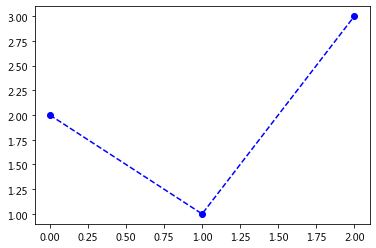жӮЁеҘҪпјҢзҷ»еҪ•еҗҺжүҚиғҪдёӢи®ўеҚ•е“ҰпјҒ
жӮЁеҘҪпјҢзҷ»еҪ•еҗҺжүҚиғҪдёӢи®ўеҚ•е“ҰпјҒ
жң¬зҜҮеҶ…е®№д»Ӣз»ҚдәҶвҖңеҰӮдҪ•дҪҝз”Ёmatplotlibдёӯзҡ„жҠҳзәҝеӣҫж–№жі•plot()вҖқзҡ„жңүе…ізҹҘиҜҶпјҢеңЁе®һйҷ…жЎҲдҫӢзҡ„ж“ҚдҪңиҝҮзЁӢдёӯпјҢдёҚе°‘дәәйғҪдјҡйҒҮеҲ°иҝҷж ·зҡ„еӣ°еўғпјҢжҺҘдёӢжқҘе°ұи®©е°Ҹзј–еёҰйўҶеӨ§е®¶еӯҰд№ дёҖдёӢеҰӮдҪ•еӨ„зҗҶиҝҷдәӣжғ…еҶөеҗ§пјҒеёҢжңӣеӨ§е®¶д»”з»Ҷйҳ…иҜ»пјҢиғҪеӨҹеӯҰжңүжүҖжҲҗпјҒ
plt.plot()зҡ„е®ҡд№үеҸҠи°ғз”Ё
е®ҡд№үпјҡ
plt.plot(*args, scalex=True, scaley=True, data=None, **kwargs)
и°ғз”Ёпјҡ
plot([x], y, [fmt], *, data=None, **kwargs)
plot([x], y, [fmt], [x2], y2, [fmt2], ..., **kwargs)
дҪҚзҪ®еҸӮж•°пјҡ
[x], y, [fmt]
е…ій”®еӯ—дј еҸӮпјҡ
*еҗҺйқўзҡ„еҸӮж•°
xеәҸеҲ—зҡ„дёҚеҗҢзұ»еһӢ
ж–Үжң¬еһӢзҡ„xеәҸеҲ—
# data X = [8,3,5,'t'] # дјҡжҢүйЎәеәҸгҖҗ0,1,2,3гҖ‘иў«е®ҡдҪҚеңЁxиҪҙзҡ„еҲ»еәҰдёҠ Y = [1,2,3,4] plt.plot(X,Y,marker = 'o',c='g') ax = plt.gca() print('xиҪҙеҲ»еәҰпјҡ',plt.xticks()) #list xticklabels_lst = ax.get_xticklabels() print('-'*70)xиҪҙеҲ»еәҰпјҡ([0, 1, 2, 3], <a list of 4 Text xticklabel objects>)
----------------------------------------------------------------------

print('xиҪҙеҲ»еәҰж Үзӯҫпјҡ',list(xticklabels_lst)) #жҳҜдёӘж–Үжң¬ж ҮзӯҫxиҪҙеҲ»еәҰж Үзӯҫпјҡ[Text(0, 0, '8'), Text(1, 0, '3'), Text(2, 0, '5'), Text(3, 0, 't')]
ж•°еӯ—еһӢзҡ„xеәҸеҲ—
# data X = [8,3,5,1] # дјҡжҢүж•°еӯ—гҖҗ8пјҢ3,5,1гҖ‘иў«е®ҡдҪҚеңЁxиҪҙзҡ„еҲ»еәҰдёҠ Y = [1,2,3,4] plt.plot(X,Y,marker = 'o',c='g') ax = plt.gca() print('xиҪҙеҲ»еәҰпјҡ',plt.xticks()) # array xticklabels_lst = ax.get_xticklabels() print('-'*70)xиҪҙеҲ»еәҰпјҡ(array([0., 1., 2., 3., 4., 5., 6., 7., 8., 9.]), <a list of 10 Text xticklabel objects>)
----------------------------------------------------------------------

print('xиҪҙеҲ»еәҰж Үзӯҫпјҡ',list(xticklabels_lst)) #жҳҜдёӘжҢүеәҸеҸ·жҺ’еҲ—зҡ„ж–Үжң¬ж ҮзӯҫxиҪҙеҲ»еәҰж Үзӯҫпјҡ[Text(0.0, 0, '0'), Text(1.0, 0, '1'), Text(2.0, 0, '2'), Text(3.0, 0, '3'), Text(4.0, 0, '4'), Text(5.0, 0, '5'), Text(6.0, 0, '6'), Text(7.0, 0, '7'), Text(8.0, 0, '8'), Text(9.0, 0, '9')]
2з§Қзұ»еһӢ-2жқЎзәҝ
# data X1 = [8,3,5,'t'] X2 = [8,3,5,1] Y = [1,2,3,4] plt.plot(X2,Y,marker = 'o',c='r') plt.plot(X1,Y,marker = 'o',c='g') ax = plt.gca() print('xиҪҙеҲ»еәҰпјҡ',plt.xticks()) xticklabels_lst = ax.get_xticklabels() print('-'*70)xиҪҙеҲ»еәҰпјҡ([0, 1, 2, 3], <a list of 4 Text xticklabel objects>)
----------------------------------------------------------------------

print('xиҪҙеҲ»еәҰж Үзӯҫпјҡ',list(xticklabels_lst))xиҪҙеҲ»еәҰж Үзӯҫпјҡ[Text(0, 0, '8'), Text(1, 0, '3'), Text(2, 0, '5'), Text(3, 0, 't')]
жҸҗдҫӣдёҚеҗҢж•°йҮҸзҡ„дҪҚзҪ®еҸӮж•°
еҮ з§Қж–№ејҸзҡ„и°ғз”Ё
ж— еҸӮж•°
#иҝ”еӣһдёҖдёӘз©әеҲ—иЎЁ plt.plot()
[]

plot([x], y, [fmt], *, data=None, **kwargs) plot([x], y, [fmt], [x2], y2, [fmt2], ..., **kwargs)
1дёӘеҸӮж•°
#жҸҗдҫӣдёҖдёӘж•°пјҲзӮ№пјү plt.plot(4.5,marker='o')
[<matplotlib.lines.Line2D at 0x7f6f0352f978>]

#жҸҗдҫӣдёҖдёӘж•°еӯ—еәҸеҲ— plt.plot([4.5,2,3],marker='o')
[<matplotlib.lines.Line2D at 0x7f6f0350d438>]

2дёӘеҸӮж•°
иҮӘеҠЁи§ЈжһҗдҪҚзҪ®еҸӮж•°зҡ„еҺҹеҲҷ
(x,yпјүеҪўејҸ
# x/y дёәеәҸеҲ— plt.plot([2,1,3],[0.5,2,2.5],marker='o')
[<matplotlib.lines.Line2D at 0x7f6f034735c0>]

# x/y дёәж ҮйҮҸ plt.plot(2,['z'],marker = 'o')
[<matplotlib.lines.Line2D at 0x7f6f03461b38>]

(y,fmt)еҪўејҸ
# plt.plot(2,'z',marker = 'o') #Unrecognized character z in format string
# y дёәж ҮйҮҸ plt.plot(2,'r',marker = 'o')
[<matplotlib.lines.Line2D at 0x7f6f033b7cf8>]

# y дёәеәҸеҲ— plt.plot([2,1,3],'r--*')
[<matplotlib.lines.Line2D at 0x7f6f033a1cf8>]

3дёӘеҸӮж•°
пјҲ[x],y,[fmt]пјүеҪўејҸ
plt.plot([2,1,3],[0.5,2,2.5],'p--g', # marker='o' markersize = 15 )
[<matplotlib.lines.Line2D at 0x7f6f0331e048>]

# fmtдёҚеҶҷпјҢжҲ–иҖ…‘’пјҢеҲҷдҪҝз”Ёй»ҳи®Өж ·ејҸ plt.plot([2,1,3],[0.5,2,2.5],'', # marker='o' markersize = 15 )
[<matplotlib.lines.Line2D at 0x7f6f03289390>]

з»ҳеӣҫLine2D
д»…з”»зәҝпјҡз»ҳеӣҫзҡ„й»ҳи®Өжғ…еҶө
й»ҳи®Өж ·ејҸпјҡи“қиүІзҡ„гҖҗзәҝгҖ‘гҖҗж— ж Үи®°гҖ‘
# marker = None иЎЁзӨәдёҚеҒҡи®ҫзҪ® plt.plot([2,2.5,1])
[<matplotlib.lines.Line2D at 0x7f6f031f86a0>]

д»…з”»ж Үи®°
plt.plot([2,2.5,1],'o')
[<matplotlib.lines.Line2D at 0x7f6f03afcba8>]

з”»зәҝ+ж Үи®°
plt.plot([2,2.5,1],'o-')
[<matplotlib.lines.Line2D at 0x7f6f031d62e8>]

plt.plot([2,1,3],'bo--')
[<matplotlib.lines.Line2D at 0x7f6f0317b128>]

fmtзҡ„з»„еҗҲйЎәеәҸйҡҸж„Ҹзҡ„пјҹ
6еӣҫеҗҲдёҖеҸҠз»“и®ә
# 6з§Қз»„еҗҲ # [color][marker][line],3з§Қд»»ж„Ҹз»„еҗҲдёә6з§ҚеҸҜиғҪ # b :и“қиүІ # o: еңҶеңҲж Үи®° # --пјҡиҷҡзәҝ fmt = ['bo--','b--o','ob--','o--b','--bo','--ob'] for i in range(len(fmt)): plt.subplot(2,3,i+1) plt.plot([2,1,3],fmt[i]) # з»“и®әпјҡ[color][marker][line]пјҢжҜҸдёӘйғҪжҳҜеҸҜйҖүзҡ„пјҢжҜҸдёӘеұһжҖ§еҸҜд»ҘйҖүжӢ©еҶҷжҲ–иҖ…дёҚеҶҷ # иҖҢдё”дёҺз»„еҗҲдёӯе®ғ们жүҖеңЁзҡ„дҪҚзҪ®йЎәеәҸж— е…і

fmtж”ҜжҢҒзҡ„гҖҗзәҝгҖ‘-line
Line Styles
==== character description ====
'-' solid line style '--' dashed line style '-.' dash-dot line style ':' dotted line style
fmtж”ҜжҢҒзҡ„гҖҗж Үи®°гҖ‘-marker
Markers
==== character description ====
'.' point marker ',' pixel marker \\\'o\\\' circle marker 'v' triangle_down marker '^' triangle_up marker '<' triangle_left marker '>' triangle_right marker '1' tri_down marker '2' tri_up marker '3' tri_left marker '4' tri_right marker 's\\\' square marker 'p' pentagon marker '*' star marker 'h' hexagon1 marker 'H' hexagon2 marker '+' plus marker 'x' x marker 'D' diamond marker 'd' thin_diamond marker '|' vline marker '_' hline marker
fmtж”ҜжҢҒзҡ„гҖҗйўңиүІгҖ‘-color
Colors
The supported color abbreviations are the single letter codes
==== character color ====
'b' blue 'g' green 'r' red 'c' cyan 'm' magenta 'y' yellow 'k' black 'w' white
жүҖжңүж ·ејҸпјҡж Үи®°гҖҒзәҝгҖҒйўңиүІеҸӮиҖғеӨ§е…Ё
й“ҫжҺҘпјҡhttps://www.kesci.com/home/project/5ea4e5da105d91002d506ac6
ж ·ејҸеұһжҖ§
зәҝжқЎзҡ„еұһжҖ§
# еҢ…еҗ«пјҡ(йўңиүІйҷӨеӨ–пјү # зәҝзҡ„ж ·ејҸгҖҒзәҝзҡ„е®ҪеәҰ # linestyle or ls: {'-', '--', '-.', ':', '', } # linewidth or lw: float ls_lst = ['-', '--', '-.', ':',] lw_lst = [1,3,5,7] for i in range(len(ls_lst)): plt.plot([1,2,3,4],[i+1]*4,ls_lst[i],lw = lw_lst[i])
ж Үи®°зҡ„еұһжҖ§
# еҢ…еҗ«пјҡ ''' marker: marker style #иҫ№жЎҶпјҲйўңиүІеҸҠиҫ№жЎҶзІ—з»Ҷпјү markeredgecolor or mec: color markeredgewidth or mew: float #йқўйўңиүІ markerfacecolor or mfc: color markerfacecoloralt or mfcalt: color #еӨҮз”Ёж Үи®°йўңиүІ #ж Үи®°зҡ„еӨ§е°Ҹ markersize or ms: float markevery: None or int or (int, int) or slice or List[int] or float or (float, float) ''' # linestyle = None иЎЁзӨәдёҚеҒҡи®ҫзҪ®пјҢд»Ҙй»ҳи®ӨеҖјж–№ејҸ # linestyle = '' linestyle = 'none' иЎЁзӨәж— ж јејҸпјҢж— зәҝжқЎ plt.plot([4,2,1,3],linestyle = 'none', marker = 'o', markersize = 30, # edge markeredgecolor = 'r', markeredgewidth = 5, # face markerfacecolor = 'g', # markerfacecolor = 'none', # markerfacecolor = None, )
[<matplotlib.lines.Line2D at 0x7f6f02f085c0>]

з»јеҗҲпјҡеёҰжңүз©әеҝғеңҶж Үи®°зҡ„зәҝжқЎеӣҫ
''' ж Үи®°зӮ№жҳҜиҰҶзӣ–еңЁзәҝжқЎзҡ„дёҠйқўпјҢдҪҚдәҺдёҠеұӮ еӣҫеұӮеұӮж¬Ўпјҡ[top] spines > marker > line > backgroud [bottom] spinesпјҡиҪҙзҡ„4дёӘиҫ№жЎҶ spines е°ҶзәҝжқЎеӣҫеӣҙеңЁйҮҢйқў ''' plt.plot([1,5,3,4], marker = 'o', markersize = 20, # edge markeredgecolor = 'r', markeredgewidth = 5, # face markerfacecolor = 'w', # зҷҪиүІпјҢдёҺиғҢжҷҜиүІзӣёеҗҢпјҢжҠҠзәҝжқЎиҰҶзӣ–зқҖпјҢиҗҘйҖ з©әеҝғзҡ„и§Ҷи§үж•Ҳжһң # markerfacecolor = 'none', # ж— иүІпјҢйҖҸжҳҺпјҢдјҡзңӢеҲ°зәҝжқЎ # markerfacecolor = None, # дёҚи®ҫзҪ®пјҢй»ҳи®ӨйўңиүІ ) # markerfacecolor = ' ', # ж— жі•иҜҶеҲ« # markerfacecolor = '', # ж— жі•иҜҶеҲ«
[<matplotlib.lines.Line2D at 0x7f6f02e6e470>]

dataе…ій”®еӯ—зҡ„дҪҝз”Ё
еӯ—е…ёж•°жҚ®
#еӯ—е…ёж•°жҚ® d = {'name':list('abcd'),'age':[22,20,18,27]} plt.plot('name','age',ddata = d)[<matplotlib.lines.Line2D at 0x7f6f02e52e48>]

DataFrameж•°жҚ®
#DataFrameж•°жҚ® d = {'name':list('abcd'),'age':[22,20,18,27]} df = pd.DataFrame(d) df| name | age | |
|---|---|---|
| 0 | a | 22 |
| 1 | b | 20 |
| 2 | c | 18 |
| 3 | d | 27 |
plt.plot('name','age',data = df)[<matplotlib.lines.Line2D at 0x7f6f02d7a940>]

вҖңеҰӮдҪ•дҪҝз”Ёmatplotlibдёӯзҡ„жҠҳзәҝеӣҫж–№жі•plot()вҖқзҡ„еҶ…е®№е°ұд»Ӣз»ҚеҲ°иҝҷйҮҢдәҶпјҢж„ҹи°ўеӨ§е®¶зҡ„йҳ…иҜ»гҖӮеҰӮжһңжғідәҶи§ЈжӣҙеӨҡиЎҢдёҡзӣёе…ізҡ„зҹҘиҜҶеҸҜд»Ҙе…іжіЁдәҝйҖҹдә‘зҪ‘з«ҷпјҢе°Ҹзј–е°ҶдёәеӨ§е®¶иҫ“еҮәжӣҙеӨҡй«ҳиҙЁйҮҸзҡ„е®һз”Ёж–Үз« пјҒ
е…ҚиҙЈеЈ°жҳҺпјҡжң¬з«ҷеҸ‘еёғзҡ„еҶ…е®№пјҲеӣҫзүҮгҖҒи§Ҷйў‘е’Ңж–Үеӯ—пјүд»ҘеҺҹеҲӣгҖҒиҪ¬иҪҪе’ҢеҲҶдә«дёәдё»пјҢж–Үз« и§ӮзӮ№дёҚд»ЈиЎЁжң¬зҪ‘з«ҷз«ӢеңәпјҢеҰӮжһңж¶үеҸҠдҫөжқғиҜ·иҒ”зі»з«ҷй•ҝйӮ®з®ұпјҡis@yisu.comиҝӣиЎҢдёҫжҠҘпјҢ并жҸҗдҫӣзӣёе…іиҜҒжҚ®пјҢдёҖз»ҸжҹҘе®һпјҢе°Ҷз«ӢеҲ»еҲ йҷӨж¶үе«ҢдҫөжқғеҶ…е®№гҖӮ